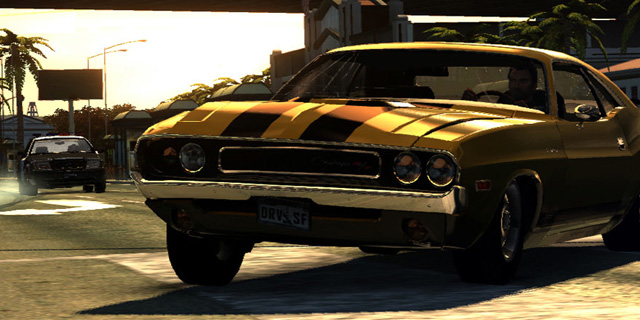
Driver is finally exactly what it needs to be – a game that is not trying to be Grand Theft Auto. Between Saint’s Row, Mafia, True Crime, Just Cause, and, well, Grand Theft Auto, the anti-hero sandbox landscape is fairly crowded. Ubisoft Reflections seems to have realized this and made a game that feels similar enough to feel familiar but is different enough that it is its own unique brand of fun.
First and foremost, Driver: San Francisco is a game about driving various cars. And it should be – it’s called Driver. There are no on-foot portions, no weapons to fumble with, and no jamming two mediocre games into one box instead of one good one. Second, Driver is not a dark game. Yes, you’re playing as cop, John Tanner, trying once again to take down career criminal Chris Jericho, but Driver San Francisco puts fun gameplay elements and great cars ahead of storytelling. You’ll find yourself seeking out the wacky side missions because they’re fun instead of because you need to complete them to unlock story missions.
Five minutes in, things get strange. You’ll begin in the real world, escorting Jericho’s transport truck from the prison to the courthouse. Jericho escapes, and while you’re chasing him around the city, Tanner’s car is t-boned by an 18-wheeler, leaving him in a coma. From here on, everything happens inside Tanner’s mind, which explains why you can press A to leave your body and view the city from above, pan around the map, and choose a new car to drive by possessing the current driver. This odd ability makes takedowns and races interesting, because swapping cars to run your opponents off the road is a valid (and encouraged) strategy. You’ll find yourself running two cars in street races, getting a man to the hospital while keeping his heart rate up so he doesn’t succumb to a spider bite and defusing bombs under trucks by driving underneath them on the highway on a tight schedule (10 trucks in three minutes scattered throughout the city).
Losing the interior segments and gunplay allowed Ubisoft Reflections to really focus on the car handling and selection. I don’t care that the Alfa Romeo 159 was never sold in the US – I love that it’s available in the San Francisco in John Tanner’s mind. All-wheel drive cars perform better off-road than rear- and front-wheel drive cars, which oversteer and understeer like you should expect them to do. It’s important to choose the right car for the task at hand, and if you bring a horrible, drifty Corvette to an off-road race you can expect to, and should, lose to all of the guys racing around in dune buggies. You’ll find Murcielagos, Zondas, Countachs, Jaguars, and just about every other car that the boys on Top Gear go nuts over, and the sense of speed when you shift into a MacLaren F1 and accelerate down the wrong side of the highway is amazing.
I could go on and on about how the VW Scirocco sounds just right and the dashboard gauges are actually modeled on their real-world counterparts, but I think I’ve made my point. If you’re a petrol-head, then you’ll be pleased with the selection and treatment of the cars in Driver San Francisco. Multiplayer is well-represented as well. Vanilla racing works well because the great driving mechanics are carried over from single player, but the experience you’ll remember are game modes like Tag, with drivers shifting from car to car all the while. Driver is finally a game that you need to buy because it has stopped trying to be Grand Theft Auto and started being Driver – which, it turns out, is a very fun game.
Pros: Car selection, focus on driving over realism
Cons: You’ll need to accept the disconnect from reality



















